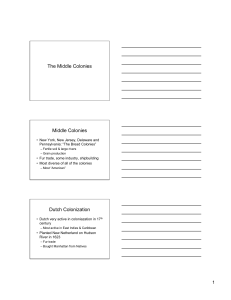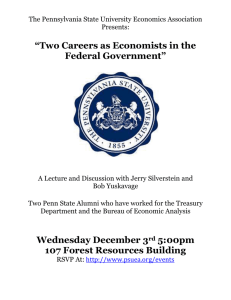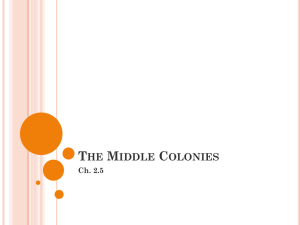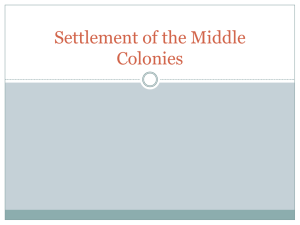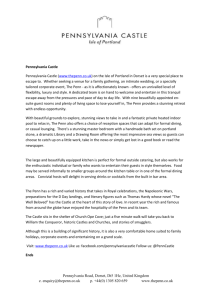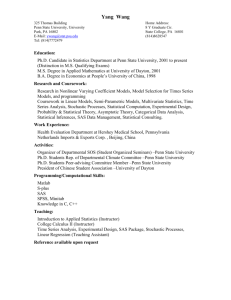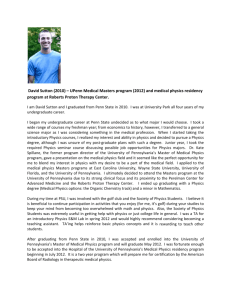The Middle Colonies - Mr. Casali's History Classes
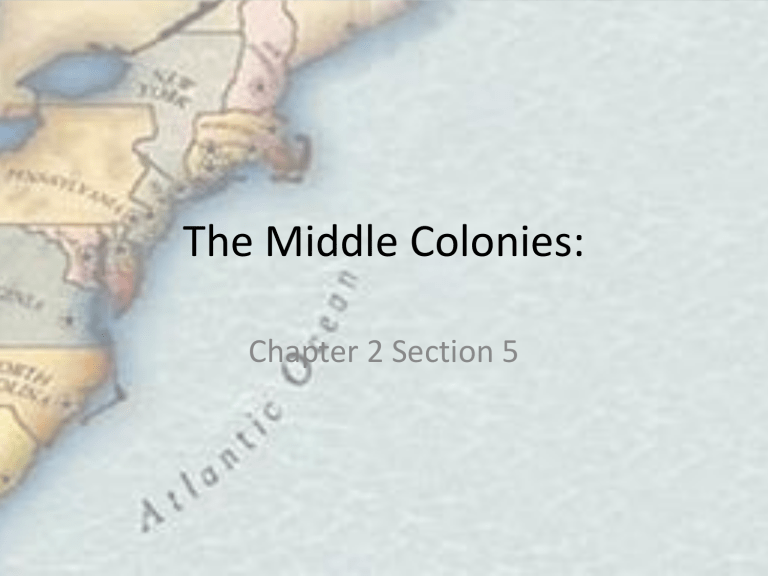
The Middle Colonies:
Chapter 2 Section 5
Middle Colonies
The 13 Colonies:
1) New Netherlands:
A) New Amsterdam:
• 1609: The Dutch began trading furs with the
N.A.s along the Hudson River.
• To protect their trade they built New
Amsterdam on the tip of Manhattan Island.
– One of the best harbors in the colonies.
• Like the English colonies, most colonists were middle class and poor
– Came in families
New Amsterdam:
1) New Netherlands:
B) Government
• The Dutch West India Company appointed a governor
• Did not allow an elected assembly.
• Tolerated various religious and ethnic groups.
– Jews, French, Germany and Norway
1) New Netherlands:
C) Push-and-Pull Factors:
• 1660: Population was only 5,000
– Chesapeake: 25,000
– New England: 33,000
• Pull Factors: Attract people to a new location
– Promise of a better life, fertile soil, and your own land
C) Push-and-Pull Factors:
(continued)
• Push factors: Motivate people to leave their home country
– Netherlands has a booming economy and high standard of living
– Less religions trouble
– Less reason for Dutch people to leave the
Netherlands
Review Quiz:
• Why did New Netherlands have a diverse population?
• Why did New Netherlands struggle to attract colonists?
• Compare and Contrast the governments of
New Netherlands with those in New England:
2) The English Conquest:
• 1650s and 1660s the Dutch and English are rivals.
– The English wanted New Amsterdam and its shipping
• The English attacked New Amsterdam
• Faced with being destroyed, Dutch Governor
Stuyvesant surrendered to the English
• The English made it a proprietary colony and renamed it New York
Peter Stuyvesant, in 1664, standing among residents of New
Amsterdam who are pleading with him to surrender to the
British who have arrived in warships to claim the territory for
England
3) William Penn’s Pennsylvania:
A) Debt:
• 1680: King Charles II gave William Penn the land west of the
Delaware River to pay for debt
• Named it Pennsylvania
– Means Penn’s Woods
3) William Penn’s Pennsylvania:
B) Quakers:
• Penn was a Quaker
• Quaker beliefs:
– People should follow their “Inner Light” to help understand the Bible
– Pacifists: avoid violence
– Women and men were equal spiritually
– Tolerant of other faiths
3) William Penn’s Pennsylvania:
C) Proprietary Colony:
• William Penn as governor
• Appointed three commissioners:
– Instructed them to be “just and courteous” to all N.A.s
• Buy land
• Fair price for fur
• Sit down and talk
• Established Philadelphia as the capital.
– “City of Brotherly Love”
• Penn planned
Philadelphia to include wide streets, parks and hospitals
3) William Penn’s Pennsylvania:
D) Growth:
• 1682: Penn arrives with 23 ships and 2,000 colonists
– Mostly middle class families
• Temperate climate, fertile soil, navigable rivers, and better relations with N.A.s
– 1700: 18,000 colonists
William Penn dealing fairly with the N.A.s
4) Diversity in the Middle Colonies:
• Greater diversity than New England and the
Southern colonies
• No religious denomination or ethnic group was a majority
• Proved that political order did not depend on ethnic or religious uniformity
• Basis for America’s future.
Homework
• Assignment 1: #1,2,4
• Assignment 2: #4-6
• Assignment 3: #3,5,6
